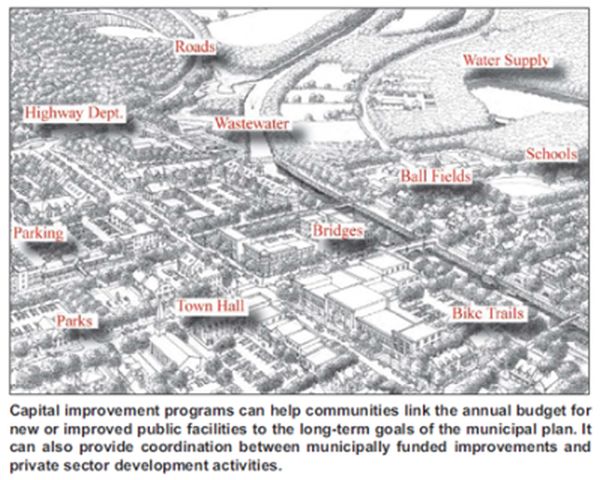 Your community has already made considerable investments in infrastructure. Going forward, your decisions about capital expenses are critical to protect public safety, reduce disruption, avoid flood damage and foster flood-safe development.
Your community has already made considerable investments in infrastructure. Going forward, your decisions about capital expenses are critical to protect public safety, reduce disruption, avoid flood damage and foster flood-safe development.
Links to sections below:
- What is the Capital Program and Budget?
- The Municipal Plan in Capital Budgeting
- Capital Priorities for Flood Resilience Communities
- Investing in Flood Resilience
What is the Capital Program and Budget?
The Select Board adopts a Capital Program and Budget on an annual basis following a hearing. The Capital Program and Budget specifies the projects and funding in the current year as needed to schedule and accomplish the objectives in the Municipal Plan.
- 24 V.S.A. § 4430. Capital budget and program describing the capital budget and program
- § 4443. Adoption, amendment, or repeal of capital budget and program
- § 4403. Nonregulatory implementation tools enabling language
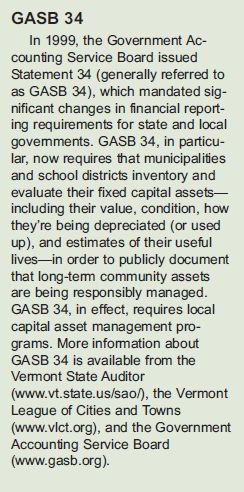 The schedule of capital investments over a number of years is generally called a Capital Improvement Program (CIP). This allows the community to prioritize capital projects and to optimize financing.
The schedule of capital investments over a number of years is generally called a Capital Improvement Program (CIP). This allows the community to prioritize capital projects and to optimize financing.
A very helpful guide to land use planning and capital improvement programs is available as:
- Implementation Manual: Vermont Land Use Planning, Vermont Planning and Information Center (VPIC)
- Capital Improvement Program (260 kb) - Further Information & Resource Links
- Facilities Management (340 kb) - Further Information & Resource Links
The Vermont League of Cities and Towns (VLCT) has a handbook on financial policies including Model Capital Program and Budget Policy (Section 6).
- Model Financial Policies Handbook: A Resource Guide for Drafting Financial Policies in Your Municipality, Vermont League of Cities and Towns, 2010
The Municipal Plan in Capital Budgeting
The Municipal Plan includes the Utility and Facility Plan summarizing the capital priorities in other sections of the plan including transportation, educational facilities, economic development, and flood resilience.
The Transportation component of the municipal plan includes a statement of needs and priorities.
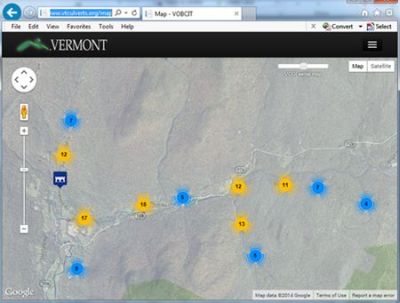 Some of this information is captured in the Town Mileage Certificate and VTrans Current Town Highway Maps (including municipal road mileage by class), as well as in a Bridge and Culvert Inventory Vermont Online Bridge and Culvert Inventory Tool (VOBCIT).
Some of this information is captured in the Town Mileage Certificate and VTrans Current Town Highway Maps (including municipal road mileage by class), as well as in a Bridge and Culvert Inventory Vermont Online Bridge and Culvert Inventory Tool (VOBCIT).
The VOBCIT data includes information on the size and condition of the structures.
Funding through VTrans and the Federal Highway Administration for municipal highways and structures is described in the Orange Book: A Handbook for Local Officials. The Orange Book describes funding opportunities such as the Town Highway Class 2 Roadway and Town Highway Structures Programs and the requirements including the need for an inventory of roads, culverts and bridges not more than three years old. The VTrans Better Back Roads Program provides grants to help inventory road-related erosion problems affecting water quality.
Some communities have completed fluvial geomorphic assessments of rivers and major tributaries.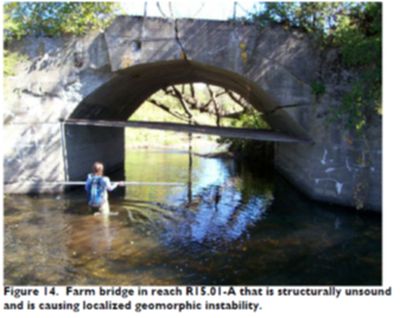
- River Corridor Reports - ANR Stream Geomorphic Assessments - Systematic assessments usually including information on the geomorphic compatibility of bridges and culverts and identifying how the structure is likely to affect adjacent road sections or buildings when it fails.
- Bridge / Culvert Reports – ANR Stream Geomorphic Assessments - Direct reports on bridge and culvert geomorphic data.
Communities that have completed geomorphic assessments of stream-crossing structures (bridges and culverts) will have the information needed regarding the dimensions needed for any replacement structure (spanning 1.2 x bankfull width) as well as the likely failure mode and correct alignment needs. This information is critical for prioritizing for public safety needs, maintaining reliable roads and estimating the cost of replacement.
Communities that have Local Hazard Mitigation Plans (LHMP) may already have a list of culverts, bridges, roads, and public buildings prioritized for public safety needs. The LHMP may be referenced by the Municipal Plan. Priorities listed in the LHMP are eligible for funding through FEMA Hazard Mitigation Grants.
Capital Priorities for Flood Resilient Communities
To become flood ready, your municipal plan and capital program may want to identify and prioritize several kinds of capital improvements including:
- Municipal plan priorities for infrastructure including those needed to promote safer places for future development;
- Local Hazard Mitigation Plan priorities;
- River Corridor Plan priorities;
- Culvert, bridge and road priorities;
- Critical facility and public buildings needs; (including water supply, wastewater facilities, equipment);
- Emergency operations needs;
- Historic structure needs;
- Acquiring flood-prone buildings in coordination with other community priorities (including restoration, greenways, and access);
- Floodplain and river corridor restoration projects;
- Hazardous materials remediation;
- Establishing a Reserve Fund to match and leverage FEMA Mitigation Assistance.
The draft Hartford Hazard Mitigation Plan (p.53) proposes to establish a Reserve Fund within the Capital Improvement Program so as to be able to effectively match and leverage FEMA Mitigation Assistance grants.

Investing in Flood Resilience
Your community’s capital program is an important non-regulatory tool to meet the goals in your municipal plan. Flood resilience is one of the many things that your community is working toward.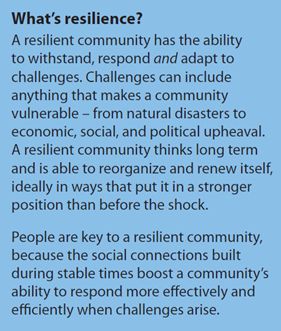
Are capital improvements well targeted to promote development in safer locations and not placed in such a way as to spur development in hazard areas?
In 2013 the Vermont Natural Resources Council published a checklist for communities examining their current work on overall resilience.
After Tropical Storm Irene communities in the Mad River Valley worked with EPA and ACCD to create:
- Disaster Recovery and Long-Term Resilience Planning in Vermont U.S. EPA Smart Growth Implementation Assistance Project Guidance Document for the State of Vermont, November 2013
To further increase the effectiveness of community plans and [Local Hazard Mitigation Plans], communities can also ensure that their capital improvement plans and budgets match the priorities outlined in their community plans and LHMPs and can prioritize capital improvements that are located in safer, less vulnerable locations. p.5
Of further note with regards to capital funding is Federal Executive Order 11988 (slide synopsis) requiring federal agencies and federal capital funding to avoid short or long-term impacts in flood hazard areas (to the extent of the 0.2%/500 year flood).



